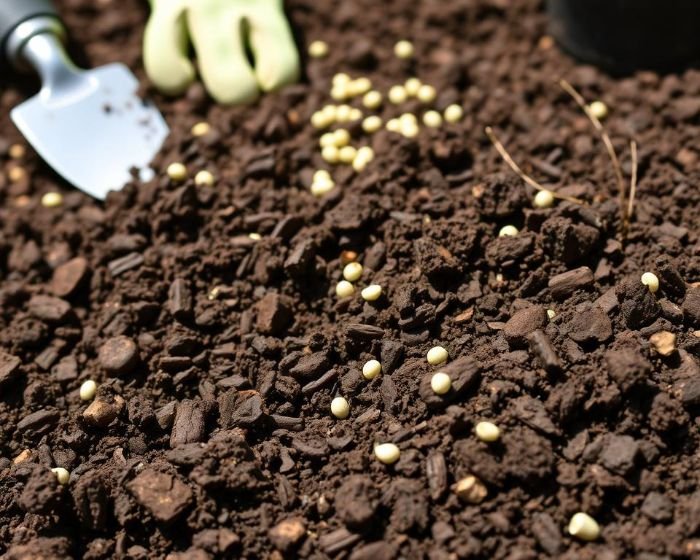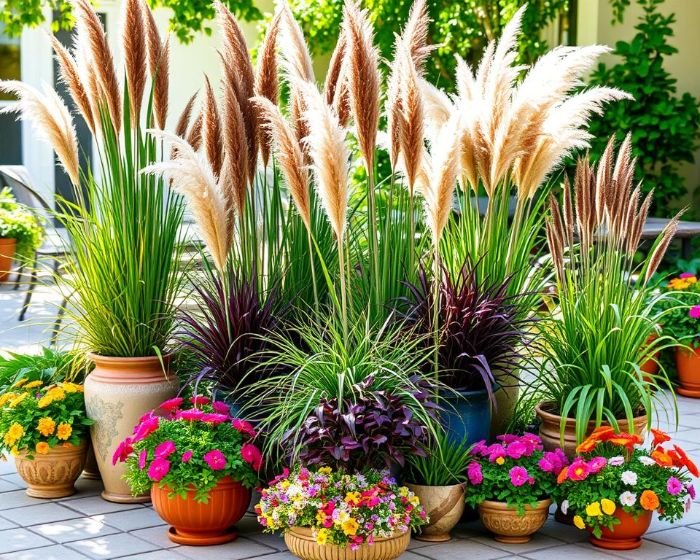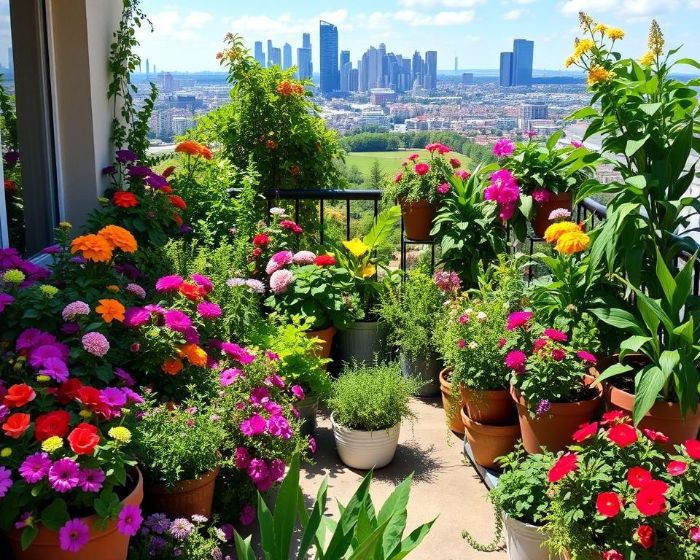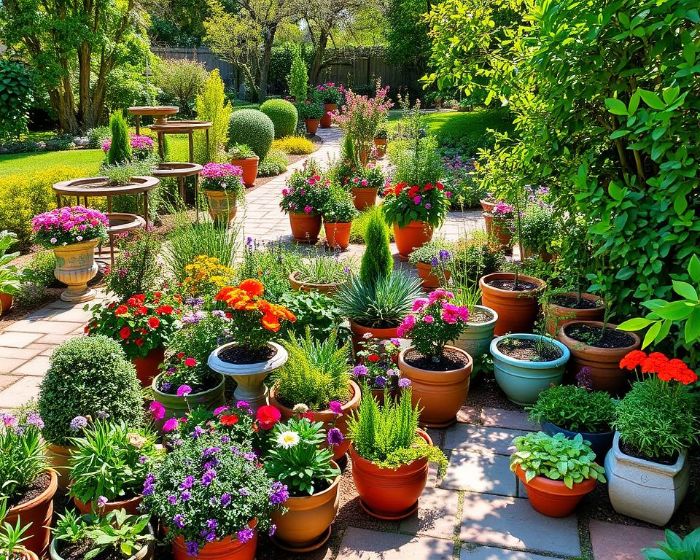Ever thought about how ornamental grasses can make a simple container look amazing? These plants boost your garden’s look and are easy to care for. They’re perfect for busy gardeners.
By using ornamental grasses in containers, you can make your patio, deck, or any outdoor area look stunning. You can control how much they spread.
But, you need to think about hardiness zones and how to protect them in winter. Still, the beautiful textures and colors they add are totally worth it.
Key Takeaways
- Ornamental grasses add beauty and movement to container gardens.
- They are low maintenance, making them ideal for busy gardeners.
- Container gardening helps control the spread of these plants.
- Seasonal changes can easily be managed with containerized ornamental grasses.
- Choose appropriate containers for optimal growth and protection.
Table of Contents
Why Use Ornamental Grasses in Containers?
Ornamental grasses offer vibrant textures and movement to container gardens, elevating both aesthetic appeal and year-round interest. Their unique textures and movement make arrangements more dynamic.
Adding Texture and Movement
Ornamental grasses have different textures. Their blades move with the wind, like flowing water. This makes spaces feel alive and engaging.
The way light and shadow play on their leaves adds depth to containers.
Year-Round Interest and Visual Appeal
These grasses look good all year. In spring, they start fresh. Summer shows off their lush look.
Fall brings beautiful colors and structure. Winter shows them standing tall, contrasting with the cold.
Low Maintenance and Drought Tolerance
Because they require minimal watering and pruning, ornamental grasses are ideal low-maintenance plants for gardeners with busy lifestyles. They can go without water, making them perfect for busy gardeners.
Best Ornamental Grasses for Container Gardens
Pairing your grasses with top plants for container gardening ensures diverse textures, colors, and growth habits for a more striking display. There are many varieties that do well in pots, each with its own look and features. Here are some top picks that do well in pots, fitting for different lights and designs.
Fountain Grass (Pennisetum)
Fountain Grass is famous for its beautiful, flowing plumes. It loves full sun, making it perfect for bright garden spots. Its elegant look adds a lively touch to any setup.
Blue Fescue (Festuca glauca)
Blue Fescue stands out with its bright blue-gray leaves. It’s great for rock gardens or as a main feature. Its small size fits well in smaller pots, adding color and texture.
Japanese Forest Grass (Hakonechloa)
Japanese Forest Grass is ideal for shady spots, with its elegant arching shape. It brings softness and calm to containers. Its green and gold colors look great with other plants.
Feather Reed Grass (Calamagrostis)
Feather Reed Grass has a tall, vertical look, adding height to containers. It’s flexible and does well in many conditions. Its unique shape and form boost the garden’s design.
Purple Fountain Grass (Pennisetum setaceum)
Purple Fountain Grass adds drama with its tall height and deep purple color. It matches many plants well. Its bold look can make your garden stand out.
Choosing the Right Containers for Ornamental Grasses
Consulting a guide to selecting the right pots can help ensure your ornamental grasses have the depth and drainage they need to flourish. These factors help create a perfect home for your plants.
Size and Depth Considerations
The size of the container affects the health of the grass roots. Big containers help the roots grow strong and get the nutrients they need. Small pots can limit growth by trapping roots.
Deep containers give roots the room they need to spread out. This is important for keeping your plants healthy.
Material Options: Ceramic, Terracotta, and Metal
Materials matter for growing ornamental grasses. Ceramic and terracotta pots let air in, which helps with drainage. Metal pots, especially dark ones, can get hot and dry out the soil. This prevents the roots from getting too wet.
Each material has its own benefits for different gardens and climates.
Drainage Solutions for Healthy Root Systems
Good drainage is vital for ornamental grasses. Without it, roots can rot from too much moisture. To prevent this, use pots with drainage holes and soil that drains well.
Adding gravel or perlite at the bottom of the pot also helps with drainage. This keeps the roots healthy.
Planting Ornamental Grasses in Containers
Planting ornamental grasses in containers needs careful thought. You must pick the right soil mix, plant them correctly, and space them well. These steps help your container garden look great and stay healthy.
Soil Preparation and Mix Recommendations
Starting with the right soil mix is key for ornamental grasses. Use compost for nutrients, topsoil for stability, and perlite for better drainage. This mix helps the roots grow strong and stops water from pooling, which can hurt the plants.
Proper Planting Techniques and Spacing
Think about the size and how your grasses will grow when planting. Leave enough space for air to move and for each plant to get what it needs. This is very important as the grasses get bigger, keeping them from growing too close together.
Combining Grasses with Other Plants for Mixed Displays
Mixing ornamental grasses with other plants makes your container garden look better. Choose plants with different colors, textures, and heights. Grasses add height and movement, making a great contrast with flowers or other plants.

Caring for Ornamental Grasses in Containers
Caring for ornamental grasses in containers means paying attention to their needs. This includes keeping them moist, giving them the right food, and doing seasonal checks. By following a good watering schedule, giving them the right food, and doing seasonal checks, these plants can do well for years. They add beauty and texture to your outdoor areas.
Watering Needs and Schedules
Ornamental grasses like consistent moisture but can handle dry spells. It’s important to have a watering plan based on the weather and the size of the pot. In hot weather, you might need to water every day. In cooler months, you can water less often. Always check the soil before watering to prevent root rot.
Fertilization Tips for Healthy Growth
Fertilizing is key for ornamental grasses. Use a balanced, high-nitrogen fertilizer every six to eight weeks when they’re growing. For new pots, slow-release fertilizers are good. They feed the plant over time without needing to be reapplied often.
Pruning and Cutting Back for Seasonal Maintenance
Seasonal care is important for ornamental grasses. Prune or cut back the foliage in late winter or early spring. This encourages new growth and keeps things looking neat. Dividing these grasses every three years helps prevent them from getting too crowded. This keeps them looking good and healthy.
Design Ideas Using Ornamental Grasses
When integrating container gardens into your overall landscape, ornamental grasses add height and visual interest that seamlessly blend with surrounding features. This makes them perfect for adding beauty and function to outdoor areas.
By using these plants, gardeners can make eye-catching spots. They can also use them as border plants. Plus, they fit well in both modern and rustic designs.
Creating Focal Points with Grasses
Ornamental grasses grab attention in a garden. They work well as focal points. Taller grasses like Fountain Grass add height.
Shorter grasses like Blue Fescue offer a nice contrast. Mixing colors and sizes makes for beautiful scenes that draw you in.
Using Grasses as Border or Edge Plants
Border plants help define paths or beds. Ornamental grasses are perfect for this. They move naturally and come in different heights.
This softens hard edges and makes spaces welcoming. Pairing them with flowers adds more beauty. It also helps areas blend smoothly together.
Incorporating Grasses into Modern and Rustic Designs
For modern designs, ornamental grasses look sleek and sophisticated. They match well with modern materials like concrete or glass.
On the other hand, these grasses bring depth to rustic designs. They go well with stone, weathered wood, or metal. Mixing different types lets you show off your style.

Troubleshooting Common Issues with Ornamental Grasses
Ornamental grasses make container gardens look great. But, they need some care to stay healthy and pretty. Fixing common problems helps keep your garden looking good.
Dealing with Pests and Diseases
Keeping pests away from ornamental grasses is key. Check them often for pests or diseases. Use things like neem oil or insecticidal soap to fight pests.
Acting fast when you see a problem stops it from getting worse.
Addressing Overgrowth and Spreading
Ornamental grasses can get too big, too fast. Cutting them back or moving them helps control their size. This keeps them from taking over and makes them easier to care for.
Winterizing Grasses for Cold Climates
Winterizing is important for ornamental grasses in cold places. Move them to a safe spot, add mulch, or cover them up. These steps help them survive the cold and come back strong next year.
Conclusion – Enhancing Your Garden with Ornamental Grasses
Ornamental grasses add beauty to container gardens with their unique textures and movements. They make patios, balconies, and gardens look inviting. Even in small spaces, these plants can bring life and beauty.
These grasses are easy to care for, making them great for all gardeners. With the right types and care, anyone can enjoy their benefits. They can tolerate drought and add interest all year round.
Adding ornamental grasses to your garden changes how your outdoor space looks and feels. With the right selection and design, they become key features. This makes your gardening experience better and your garden more beautiful.
FAQ
What are the benefits of using ornamental grasses in container gardening?
Ornamental grasses make gardens look better with their beauty and movement. They need little care, can survive with little water, and look great all year.
How do I choose the right ornamental grasses for my containers?
Look for types like Fountain Grass, Blue Fescue, Japanese Forest Grass, Feather Reed Grass, and Purple Fountain Grass. These are perfect for pots.
What size container should I use for ornamental grasses?
Use big containers for ornamental grasses. They need a deep and wide pot for their roots. This helps them grow well and stay healthy.
What materials are best for containers when growing ornamental grasses?
Use ceramic, terracotta, or metal containers for ornamental grasses. Each type affects soil temperature and keeps moisture, which affects plant health.
How do I prepare the soil for planting ornamental grasses in containers?
For ornamental grasses, mix compost, topsoil, and grit like perlite into the soil. This mix helps with drainage and gives plants what they need to grow well.
What are the watering needs for container-grown ornamental grasses?
Ornamental grasses can handle drought but still need regular water. Make sure the soil gets dry a bit before watering again to avoid too much water.
How often should I fertilize ornamental grasses in containers?
Fertilizing is key for healthy growth. Use a fertilizer high in nitrogen a few times during the growing season to help them grow strong.
What design ideas can I use with ornamental grasses in my garden?
Ornamental grasses can be the main attraction, line borders, or add to modern or rustic designs. They soften hard edges and add depth to your outdoor areas.
What should I do if my ornamental grasses in containers have pests or diseases?
Watch for pests and diseases and use organic treatments to fix them. Keeping your garden healthy helps prevent infestations.
How can I winterize ornamental grasses in colder climates?
In cold areas, protect your grasses by moving pots to safe spots or insulating them. This keeps them safe from extreme cold and helps them last longer.










